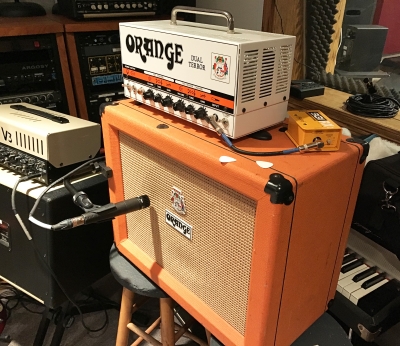
Although my previous efforts had neatened up the cable runs considerably, the main run was still crossing the drummer’s access path, so I installed a cable ramp, which protects both the drummer and the cables. While at the console, I added all of the in-use channels to a Mute Group for rehearsal breaks, and relabeled the Mix Select buttons on the console for easy access.
The large table holding the mixer and synthesizer was dominating the space. We replaced it with a smaller table from storage which fit the mixer and the IEM transmitters perfectly and made room to replace the synthesizer with the full keyboard rig.
This left a “rat’s nest” of cables beneath the table, which I couldn’t eliminate completely but managed to reduce significantly by replacing the 25-foot cables driving the IEM transmitters with much shorter “jumpers” that I labeled at both ends with spike tape, so repatching won’t cause confusion in the future.
I also consolidated the plugged-in devices into a single power strip, which allowed me to remove two power strips from the mix. After noticing the remaining power strip had a built-in USB power port, I connected the Shure battery charger (for Dave’s wireless guitar transmitters) directly to this port, which removed yet one more transformer from the tangle.
In the previous iteration of the system setup, the entire PA was powered from a wall outlet through a ground lift “cheater plug.” These things give me cold sweats. It had been installed to “fix” a ground loop hum, but an electrocuted band member is a steep price to pay for a buzzless PA.

After rewiring the entire setup, I removed the ground lift and powered up: no hum. Seems that the reworking fixed the issue. If it comes back, we’ll fix it by lifting audio ground, not electrical ground.
Providing Options
Next, Dave had recently purchased a new guitar amplifier, a Hughes and Kettner TubeMeister 36, and hadn’t had time to dig into all of the features or get his tone dialed in. The amp has a unique feature that allows the user to dynamically switch the number of output tubes via footswitch presets, creating the desired amount of tube saturation moment-by-moment during the performance.
The trick was to get the sounds Dave desired while still keeping the level consistent across the different tube settings and several guitars.
Dave and I worked together to achieve a good sound, and then I used spike tape to mark the amp’s dial positions. We were driving the guitar signal to the console via the amp’s onboard Red Box DI, which is tapped after the power amp stage and sounds really great.
There was a bit of level variation between the single-coil pickup guitars and guitars with humbuckers, but we got it straightened out by creating two banks of presets with different numbers of output tubes enabled. This kept the tone consistent while providing extra gain for the weaker signal from the single-coil pickups.

Following up on a note from the drummer that the kick drum sounded weak, I noticed that the kick mic, a Shure Beta 52, had swiveled on its stand away from the ported drum head. To prevent it from happening again, I installed a Kelly SHU drum mic holder that holds the mic suspended in perfect position.
This was my first experience installing one of these units, and I was pleasantly surprised with how quick it was. I’ve had my kick mic knocked away during shows more times than I can count, and this is the first really good solution I’ve seen.
